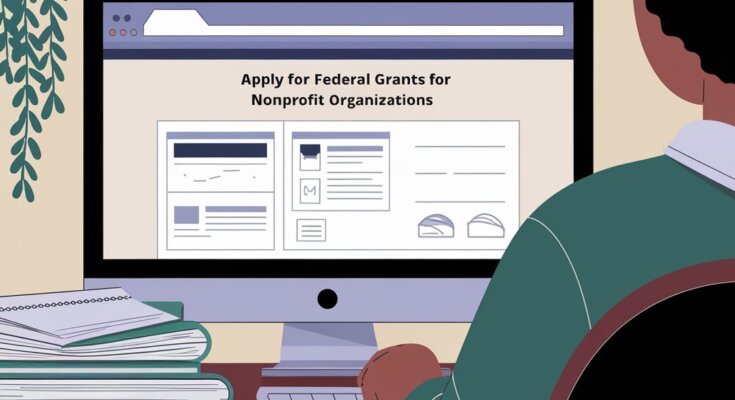Are you leading a nonprofit organization and looking for new ways to secure funding? Learning how to apply for federal grants for nonprofit organizations can be a game-changer for you.
Federal grants offer a huge opportunity for nonprofits to fund their programs, expand their reach, and make a significant impact in their communities. However, navigating the application process can be daunting if you don’t know where to start.
Why Federal Grants Are Important for Nonprofits
Federal grants can provide nonprofits with much-needed resources to kick-start new programs, sustain existing initiatives, or even cover operational expenses.
Unlike loans, these grants don’t need to be paid back, making them an ideal funding source.
But here’s the catch: the competition is stiff, and the application process can be time-consuming. So, knowing how to stand out is crucial.
Step 1: Research the Right Grants
The first step in applying for federal grants is to identify those that align with your organization’s mission. Federal agencies like the Department of Health and Human Services (HHS), the National Endowment for the Arts (NEA), and the Environmental Protection Agency (EPA) all offer grants tailored to specific causes.
Pro Tip: Use websites like Grants.gov to find federal grants. It’s a comprehensive database where you can filter grants by category, agency, or eligibility requirements. Let’s say you run a nonprofit that focuses on environmental education for kids. You could find grants from the EPA that specifically fund youth educational programs about nature.
Step 2: Understand the Eligibility Criteria
Before you spend time on an application, it’s crucial to understand the eligibility requirements.
Federal grants often have specific criteria that applicants must meet, such as being a registered 501(c)(3) nonprofit, having a certain number of years in operation, or demonstrating a history of program success.
Example: Imagine you’re leading a nonprofit focused on providing mental health services in rural areas. To apply for a grant from the Department of Health and Human Services, you need to show proof of your 501(c)(3) status, a detailed description of your services, and any past program outcomes. By ensuring you meet these criteria upfront, you’ll save yourself time and frustration.
Step 3: Prepare Key Documents
To apply for most federal grants, you’ll need to gather several key documents. These include:
- Your organization’s IRS 501(c)(3) determination letter.
- A comprehensive strategic plan that outlines your goals and how you plan to use the grant money.
- Detailed financial statements that show your organization’s financial health.
- A project budget specific to the grant you’re applying for.
These documents show funders that your organization is not only legitimate, but also has a clear plan for using the funds. Think of these as your ticket to convincing reviewers that you’re capable of delivering on your promises.
Step 4: Write a Compelling Grant Proposal
The grant proposal is your chance to shine. This document should be clear, compelling, and focused on the needs of the funding agency. Start by reading the grant guidelines thoroughly. They often include specific instructions on what to include, such as a project summary, goals, methodology, and evaluation plan.
Pro Tip: Use clear, direct language and avoid jargon. Imagine you’re telling a story about the impact you hope to make. How will your project benefit the community, and why is it crucial now?
A Story to Inspire You: The Rise of Bright Futures
When the Bright Futures Foundation started, they had a small team and big dreams to help underprivileged students access educational resources. After hearing about federal grants, they decided to apply for one through the Department of Education.
Their first application was rejected, but they didn’t give up. They revisited their strategy, made their goals clearer, and hired a grant writer to polish their proposal. I
n their second attempt, they focused on how their program would directly impact students’ academic success. This time, they secured a $100,000 grant, allowing them to provide free tutoring sessions to over 500 students in underserved areas.
Their story teaches us a valuable lesson: persistence pays off. If your first application doesn’t succeed, don’t lose hope. Use the feedback you receive to strengthen your next attempt.
Step 5: Register with SAM.gov and Grants.gov
To apply for federal grants, you must register your organization on SAM.gov (System for Award Management) and Grants.gov. This process can take a few weeks, so it’s important to start early.
Step-by-Step Tip:
- Create an account on SAM.gov and get a Unique Entity Identifier (UEI). This is a unique number for your organization.
- Once registered, head over to Grants.gov and create an account.
- Link your SAM.gov registration to Grants.gov. This allows you to submit grant applications electronically.
By completing this registration early, you avoid last-minute hurdles that could delay your submission.
Step 6: Submit the Application
When all your documents are ready and you’ve completed your proposal, it’s time to submit your application through Grants.gov. Double-check that all the required attachments are included, and your information is accurate.
Pro Tip: Make sure to submit your application a few days before the deadline. Technical issues can occur, and early submission gives you time to address any errors.
Practical Example: Submitting Your Application
Let’s say your nonprofit focuses on after-school programs for girls in STEM. You’ve found a grant from the National Science Foundation (NSF) that could help fund new robotics workshops.
You’ve written your proposal, showcasing how the workshops will increase STEM engagement among young girls in underserved communities. You submit your application through Grants.gov, attaching your project budget, strategic plan, and letters of support from local schools.
Step 7: Follow Up and Be Patient
After submitting your federal grant application, the waiting game begins. The review process can take several months. Use this time to continue building relationships with potential funders and keep your organization’s programs running smoothly.
Pro Tip: If you don’t receive the grant, ask for feedback. Most federal agencies are willing to provide comments that can help you improve future applications.
Common Mistakes to Avoid
- Missing the Deadline: Always keep track of deadlines. Missing the submission date means you’ll have to wait for the next cycle.
- Not Tailoring the Proposal: Generic proposals don’t stand out. Tailor each proposal to match the specific goals and interests of the granting agency.
- Overlooking the Budget: Your budget needs to align with the project narrative. Make sure you detail how every dollar will be spent.
Download Your Free Resource
Navigating the federal grant application process can be challenging, but you don’t have to do it alone. Download our Top 10 Donor Stewardship Strategies for Nonprofits + Free Donor Engagement Checklist to build stronger relationships with your funders. This guide will help you understand how to keep donors engaged and show them the impact of their support.
Conclusion
Learning how to apply for federal grants for nonprofit organizations may seem complicated at first, but with the right steps, you can increase your chances of success. Remember, it’s all about preparation, persistence, and presenting your nonprofit’s story in a way that aligns with the grant’s objectives.
Ready to dive deeper into the world of nonprofit funding? Subscribe to our Nonprofit Navigators Newsletter for more expert tips, resources, and exclusive content to help your organization thrive. Let’s get your nonprofit the funding it deserves!
Additional Resources:
- Digital Marketing for Nonprofits: A Comprehensive Guide to Boosting Your Impact Online
- Mastering Online Fundraising: A Nonprofit’s Guide to Digital Success
>>>>>>>>>>>>>>>>>>>>>>>>>>>>>>>>>>>>>>>>>>>>>>>>>>>>>>>>>>>>>>>>>>>>>>>>>>>>>>>
Hi, I’m Queen Israel Nweke! I help nonprofits thrive by mastering grant writing, strategic funding, and effective nonprofit management, enabling them to secure resources and make a lasting impact in their communities.
Interested in any of these services? Contact me at [email protected].




